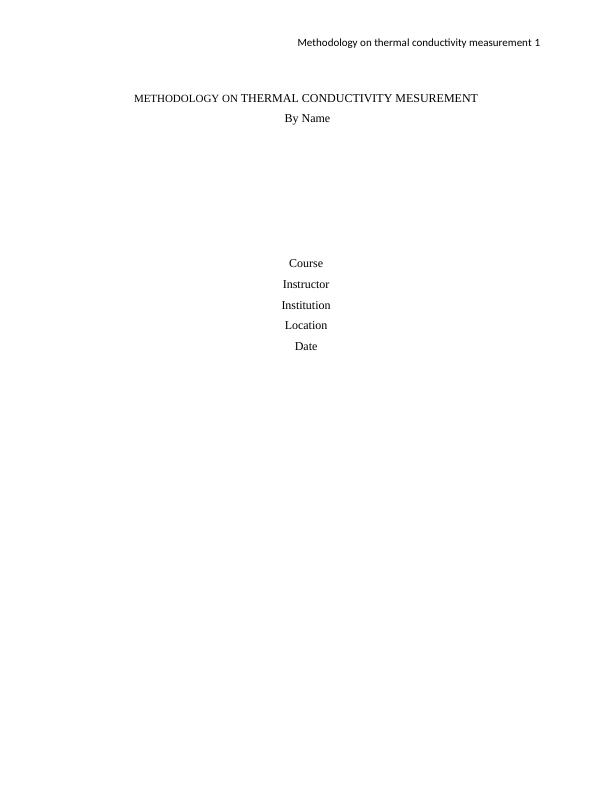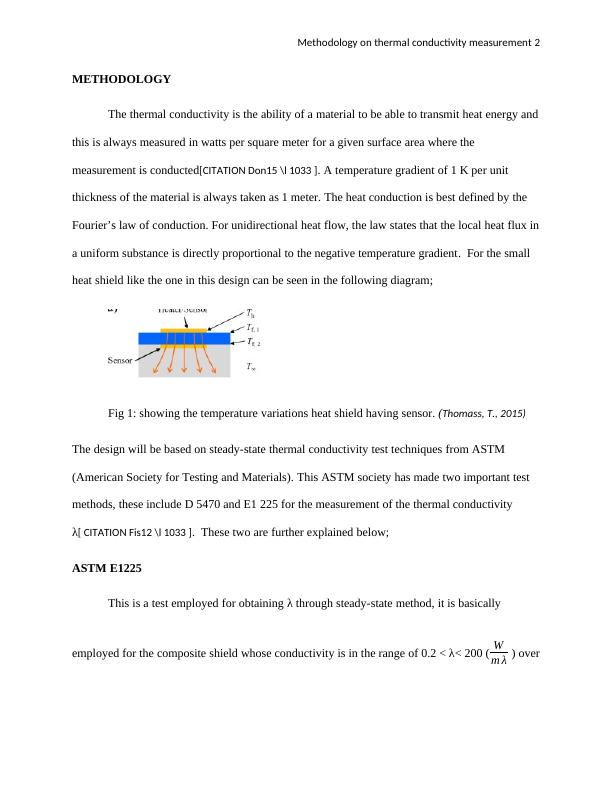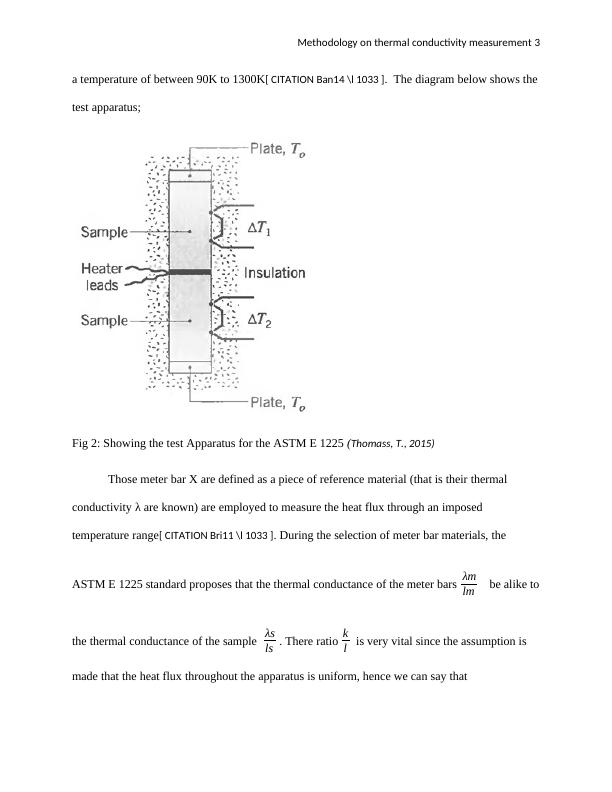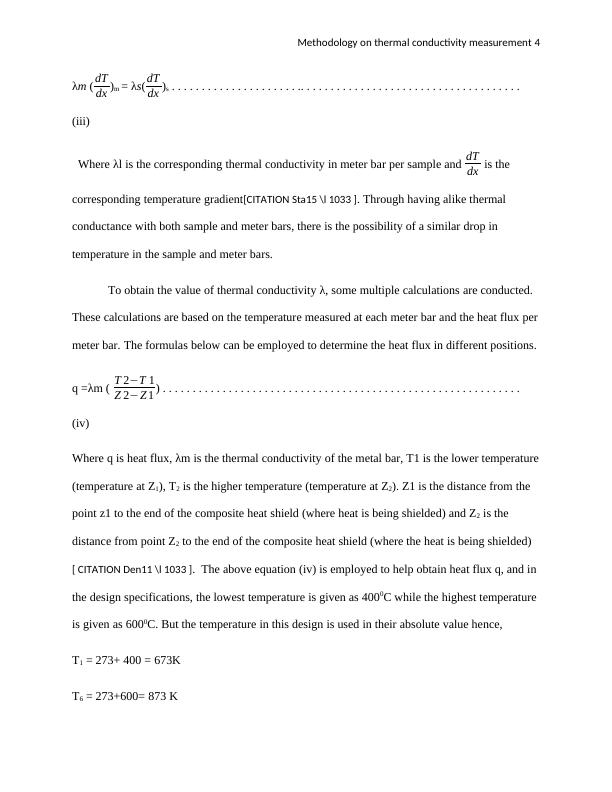Ask a question from expert
Thermal Conductivity Assignment
17 Pages3876 Words417 Views
Added on 2020-04-21
Thermal Conductivity Assignment
Added on 2020-04-21
BookmarkShareRelated Documents
Methodology on thermal conductivity measurement 1METHODOLOGY ON THERMAL CONDUCTIVITY MESUREMENTBy NameCourseInstructorInstitutionLocationDate

Methodology on thermal conductivity measurement 2METHODOLOGY The thermal conductivity is the ability of a material to be able to transmit heat energy andthis is always measured in watts per square meter for a given surface area where the measurement is conducted[CITATION Don15 \l 1033 ]. A temperature gradient of 1 K per unit thickness of the material is always taken as 1 meter. The heat conduction is best defined by the Fourier’s law of conduction. For unidirectional heat flow, the law states that the local heat flux ina uniform substance is directly proportional to the negative temperature gradient. For the small heat shield like the one in this design can be seen in the following diagram;Fig 1: showing the temperature variations heat shield having sensor. (Thomass, T., 2015)The design will be based on steady-state thermal conductivity test techniques from ASTM (American Society for Testing and Materials). This ASTM society has made two important test methods, these include D 5470 and E1 225 for the measurement of the thermal conductivity λ[ CITATION Fis12 \l 1033 ]. These two are further explained below;ASTM E1225 This is a test employed for obtaining λ through steady-state method, it is basically employed for the composite shield whose conductivity is in the range of 0.2 < λ< 200 (Wmλ ) over

Methodology on thermal conductivity measurement 3a temperature of between 90K to 1300K[ CITATION Ban14 \l 1033 ]. The diagram below shows thetest apparatus;Fig 2: Showing the test Apparatus for the ASTM E 1225 (Thomass, T., 2015)Those meter bar X are defined as a piece of reference material (that is their thermal conductivity λ are known) are employed to measure the heat flux through an imposed temperature range[ CITATION Bri11 \l 1033 ]. During the selection of meter bar materials, the ASTM E 1225 standard proposes that the thermal conductance of the meter bars λmlm be alike tothe thermal conductance of the sample λsls . There ratio kl is very vital since the assumption is made that the heat flux throughout the apparatus is uniform, hence we can say that

Methodology on thermal conductivity measurement 4λm(dTdx)m = λs(dTdx)s . . . . . . . . . . . . . . . . . . . . . .. . . . . . . . . . . . . . . . . . . . . . . . . . . . . . . . . . . . . (iii) Where λl is the corresponding thermal conductivity in meter bar per sample and dTdx is the corresponding temperature gradient[CITATION Sta15 \l 1033 ]. Through having alike thermal conductance with both sample and meter bars, there is the possibility of a similar drop in temperature in the sample and meter bars. To obtain the value of thermal conductivity λ, some multiple calculations are conducted. These calculations are based on the temperature measured at each meter bar and the heat flux permeter bar. The formulas below can be employed to determine the heat flux in different positions.q =λm ( T2−T1Z2−Z1) . . . . . . . . . . . . . . . . . . . . . . . . . . . . . . . . . . . . . . . . . . . . . . . . . . . . . . . . . . . . (iv)Where q is heat flux, λm is the thermal conductivity of the metal bar, T1 is the lower temperature(temperature at Z1), T2 is the higher temperature (temperature at Z2). Z1 is the distance from the point z1 to the end of the composite heat shield (where heat is being shielded) and Z2 is the distance from point Z2 to the end of the composite heat shield (where the heat is being shielded)[ CITATION Den11 \l 1033 ]. The above equation (iv) is employed to help obtain heat flux q, and in the design specifications, the lowest temperature is given as 4000C while the highest temperature is given as 6000C. But the temperature in this design is used in their absolute value hence, T1 = 273+ 400 = 673K T6 = 273+600= 873 K

End of preview
Want to access all the pages? Upload your documents or become a member.